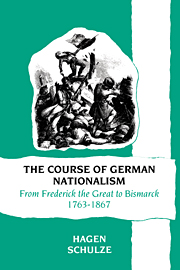Book contents
- Frontmatter
- Contents
- List of maps
- Chronological table
- Map 1 The German Confederation, 1815
- Map 2 The German Customs Union, 1834
- Introduction
- I Three weeks in March
- II The German nationalist movement's road to the creation of the Reich
- 2 The background: Europe's transformation from an agrarian society to a modern civilisation of the masses
- 3 The rise of a national culture
- 4 What has become of the German Fatherland?
- 5 The nationalist movement's passage from an elitist to a mass phenomenon
- 6 From Rhine Crisis to revolution
- 7 1848: the whole of Germany it shall be
- 8 On the road to a national economy
- 9 Speeches and majority decisions
- 10 Blood and Iron
- 11 Revolution from above and below
- III Documentary appendix
- Notes
- Bibliography and source material
- Notes to bibliography
- A critical bibliography of works in English
- Index
2 - The background: Europe's transformation from an agrarian society to a modern civilisation of the masses
Published online by Cambridge University Press: 06 January 2010
- Frontmatter
- Contents
- List of maps
- Chronological table
- Map 1 The German Confederation, 1815
- Map 2 The German Customs Union, 1834
- Introduction
- I Three weeks in March
- II The German nationalist movement's road to the creation of the Reich
- 2 The background: Europe's transformation from an agrarian society to a modern civilisation of the masses
- 3 The rise of a national culture
- 4 What has become of the German Fatherland?
- 5 The nationalist movement's passage from an elitist to a mass phenomenon
- 6 From Rhine Crisis to revolution
- 7 1848: the whole of Germany it shall be
- 8 On the road to a national economy
- 9 Speeches and majority decisions
- 10 Blood and Iron
- 11 Revolution from above and below
- III Documentary appendix
- Notes
- Bibliography and source material
- Notes to bibliography
- A critical bibliography of works in English
- Index
Summary
In the beginning was the demographic problem. After centuries of fragile equilibrium brutally maintained by wars, epidemics and famines, the population of Europe began, from the mid eighteenth century onwards, to increase rapidly. In 1750 the continent contained at a rough estimate around 130 million people; by 1800 they had already grown to around 185 million, by 1850 to 266 million, by 1900 to 401 million and on the eve of the First World War to 468 million persons. Germany was no exception; in 1750 there must have been around 17 million people living within the 1871 boundaries of the German Empire; by 1800 they already numbered 25 million, by 1850 they comprised 35.4 million, by 1900 56.4 and by 1913 67 million Germans. Not even the exodus of millions of emigrants in the last two thirds of the nineteenth century made any difference, and catastrophes which would in earlier centuries have brought about heavy setbacks, now had scarcely any effect on population growth. Silesia, for instance, lost about 50,000 inhabitants to the 1771–2 famine, but within 3 years they had been replaced by a further 70,000. Not only was the population steadily increasing, but so was its rate of growth, and this despite the fact that Europe in the 1800s was already the most heavily populated part of the world.
A whole bundle of causes was responsible for this population explosion. There was the sharp rise in agricultural production consequent on new methods of cultivation. The old three-field rotation system was replaced by modern crop rotations, improving the fertility of the soil everywhere.
- Type
- Chapter
- Information
- The Course of German NationalismFrom Frederick the Great to Bismarck 1763–1867, pp. 35 - 42Publisher: Cambridge University PressPrint publication year: 1991



